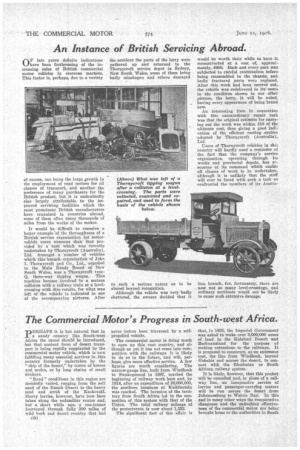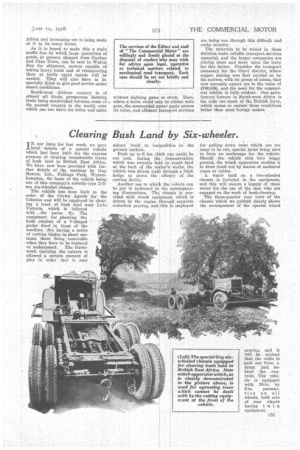The Commercial Motor's Progress in South-west Africa.
Page 52

Page 53

If you've noticed an error in this article please click here to report it so we can fix it.
Ths ERIIAPS it is but natural that in a sandy country like South-west Africa the camel should be introduced, hut that ancient form of desert transport is being rapidly supplanted by the commercial motor vehicle, which is now fulfilling many essential services in ,this country formerly undertaken by the " ship of the desert," by teams of horses and mules, or by long chains of small donkeys.
" Road " conditions in this region are decidedly varied, ranging from the soft sand of the Namib Desert to the heavy mud and scrub of the Kaokoveld. Heavy lorries, however, have now been taken along the unfamiliar routes and, but a short while ago, a one-tonner journeyed through fully 200 miles of wild bush and desert country that had
r,30 never before been traversed by a selfpropelled vehicle.
The commercial motor is doing much to open up this vast country, and although as yet it has not come into competition with the railways it is likely to do so in the future, and will, perhaps, give more effective service. A few figures are worth considering. The narrow-gauge line, built from Windhoek to Swakopmund in 1897, marked the beginning of railway work here and, by 3914, after an expenditure of £6,000,000, the southern terminus at Kalkfontein was reached. The invasion of the territory from South Africa led to the connection of this system with that of the Union. The total railway mileage of the protectorate is now about 1,352.
The significant fact of this affair is that, in 1925, the Imperial Government was asked to make over 3,000,000 acres of land in the Kalahari Desert and Bechuanaland for the • purpose of making extensions to the railways. It is proposed to construct, at an enormous cost, the line from Windhoek, beyond Gobabis and across the desert, to connect with the Rhodesian or South African railway system.
It is likely, however, that this project will be cancelled and, in place of a railway line, an inexpensive service of lorries and passenger-earrying motors will be run across the desert from Johannesburg to Walvis Bay. In this and in many other ways the 'Comparative cheapness and the undOubted effectiveness of the commercial motor are being brought home to the authorities in South Africa and increasing use is being made of it in its many forms.
As it is hoped to make this a main traffic line by which large quantities of goods, at present shipped from Durban and Cape Town, can be sent to Walvis Bay for shipment, motors capable of taking heavy loads and of transporting them at fairly rapid speeds will be needed. They will also hiave to be specially fitted to give good service under desert conditions.
South-west African country is of almost all kinds, prosperous farming lands being sandwiched between some cf the poorest country in the world, over which one can drive for miles and miles without sighting game or stock. Here, where a horse could only be ridden with pain, -the commercial motor again proves its value, and efficient transport services are being run through this difficult and rocky country.
The minerals to be mined in these districts make reliable transport services essential, and the larger companies are relying more and more upon the lorry for this factor. Consider the transport necessary for the Otavi district, where copper mining was first carried on by the natives, with its group of mines, that now annually export ore to the value of £700,000, and the need for the commercial vehicle is fully evident., One satisfactory feature in South-west Africa is the wide use made of the British lorry, which seems to endure these conditions better than most foreign makes.












































































































